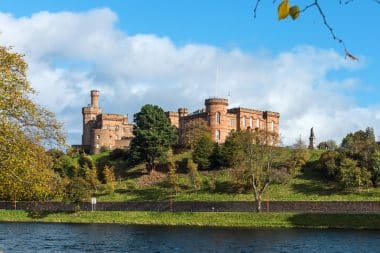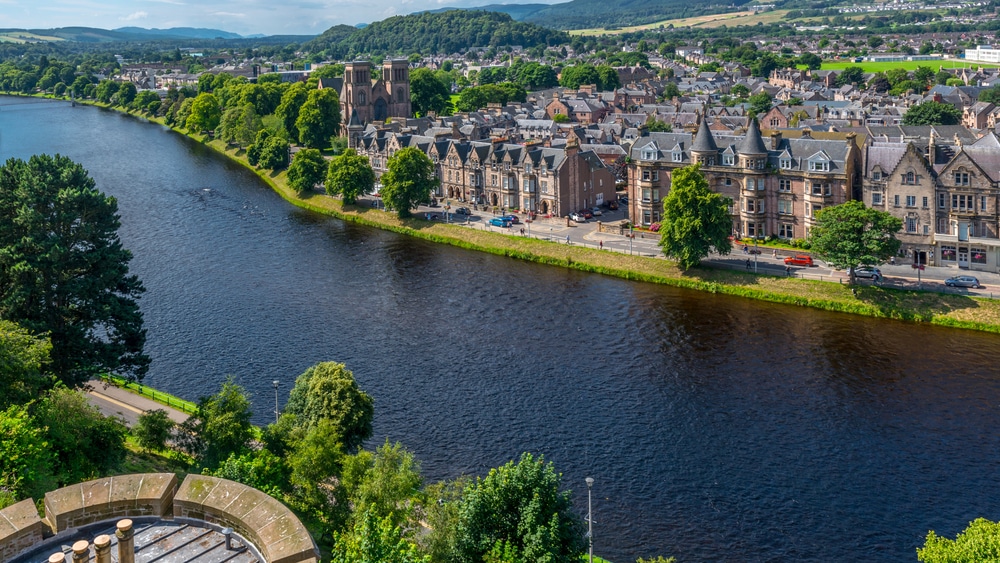Inverness – In this city, all Scotland clichés come true. Visitors don’t have to look far for whisky, castles and kilts. Inverness is called the “Capital of the Highlands” and is even officially an administrative metropolis. The city with its 46,900 inhabitants is located in the mountainous northwest of Great Britain in the Great Glen valley on the River Ness. The river rises in the legendary Loch Ness, where the monster “Nessie” is said to be up to mischief. In Inverness it flows into the Beauly Firth and from there into the Moray Firth. The city name Inverness is derived from the Gaelic word for “mouth of the Ness”.
According to Shakespeare, Macbeth became a murderer in Inverness
In addition to “Nessie”, other “celebrities” have made Inverness famous. There is Macbeth, who is made by Shakespeare in Inverness Castle into the bloodthirsty murderer of his opponent Duncan I. In truth, it shouldn’t have been that bad. Mary Stuart also lived for a short time in Stuart Castle (today’s Castle Stuart Castle Hotel) near Inverness. Last but not least, the courageous Scottish patriot Flora McDonald is worth mentioning. The city has erected a monument to her because she helped the Scottish pretender to the throne Charles Edward Stuart – known as “Bonnie Prince Charlie” – to flee from the English to France after the defeat of the Scots on the Culloden Battlefield in 1746.
Pretty buildings next to architectural sins from modern times

By car or bus, visitors can usually reach the city via the A9, which also includes Edinburgh and Glasgow. Inverness has now lost its medieval cityscape. Visitors still find the city attractive: it has pretty parks and idyllic islands in the Ness, which are connected by bridges. Unfortunately, right next to their old churches and buildings there are often soulless concrete boxes. These are the building sins from the 1960s. After all, a stroll through the small pedestrian zone Highstreet and its side streets makes holidaymakers’ hearts beat faster. This is not only due to the Old High Church from 1770 or the former town hall built in the neo-Gothic style with its pointed turrets. It is also due to the traditional shops and their products. The modern Eastgate Shopping Centre stands in stark contrast to this. But in its neighbourhood, the architecturally more beautiful “Old Eastgate” is inviting. Not to be surpassed on a shopping tour is the Wilhelminian market hall “Victorian Market” from 1870 on Academy Street. It attracts visitors with kilt and tweed shops, souvenir shops, cafes and ice cream.
Football fans wear kilts to the game
Here as there, “tartans” are popular souvenirs. These are the colourfully woven tartan patterns of the woollen fabrics from which the kilts are made – those legendary kilts of men. Tourists mainly pounce on checkered scarves and shawls. Initially, certain tartan checks stood for a region, but at the beginning of the 19th century they became the distinguishing mark of the respective Scottish clans. Kilts are hardly seen in everyday life today, but on festive occasions such as weddings. Unusual for German eyes: At the weekend, the male football fans wear kilts when they cheer on their club Inverness Caledonian Thistle in the Tulloch Caledonian Stadium with a beer can in their hands.
Beautiful view of the Lords’ magnificent houses on the banks of the Ness

Inverness Castle is perched on a hill on the River Ness, near the Greig Street Bridge from 1881 – a beautiful photo opportunity. The castle is not old and venerable, it dates back to the 19th century and is now a courthouse. That’s why visitors are not allowed in at all. However, a tower has been opened for them. Even from the castle garden you can enjoy the view of the Victorian houses of the former Scottish nobles along the banks of the Ness. And in front of the castle, the aforementioned Flora McDonald stands on her pedestal and looks across the river as if she were expecting someone. The most beautiful view is from the nearby observation deck “Castle Viewpoint”. Where the castle stands today, fortresses and castles stood many centuries ago.
Traditional dish haggis is similar to the Palatinate pig’s stomach
Inverness offers a whole range of international restaurants. But if you rely on Scottish cuisine, you should try “haggis”. This is a traditional dish that resembles “our” Palatinate pig’s stomach: A sheep’s stomach is filled with all kinds of sheep innards and oatmeal and stewed. This creates a kind of sausage that is served hot with cooked white cabbage, mashed potatoes and white sauce. In the meantime, there are somewhat more modern variants. By the way, Scottish afternoon tea is sweeter than English tea and consists of three courses: sandwiches, scones with clotted cream – sweet rolls with thick cream – and candied fruit or shortbread for “dessert” – these are cookies made of shortcrust pastry.
On a whisky tour through the Highlands
If you stay longer in the city, use Inverness as a starting point for excursions. The tour to the scenic Highlands with its castles, forests, waterfalls, deep lakes, rugged cliffs and treeless moors is offered by many tour operators and can be combined with a whisky tour. The Highland distilleries and their spirits are very well known and praised by connoisseurs. In addition to whisky tastings, many distilleries offer their visitors guided tours, souvenirs and appetizers. Visitors can visit the Loch Ness Monster by boat via the Caladonian Canal. A tour of a completely different kind, on the other hand, is a pub tour of Inverness. It should be a must! Scottish folk and pop music can be heard live almost every evening in the old town. Visitors were supposed to take part in a “ceilidh” there. This is a Scottish pub party where people drink, make music, dance and sing – often together.


